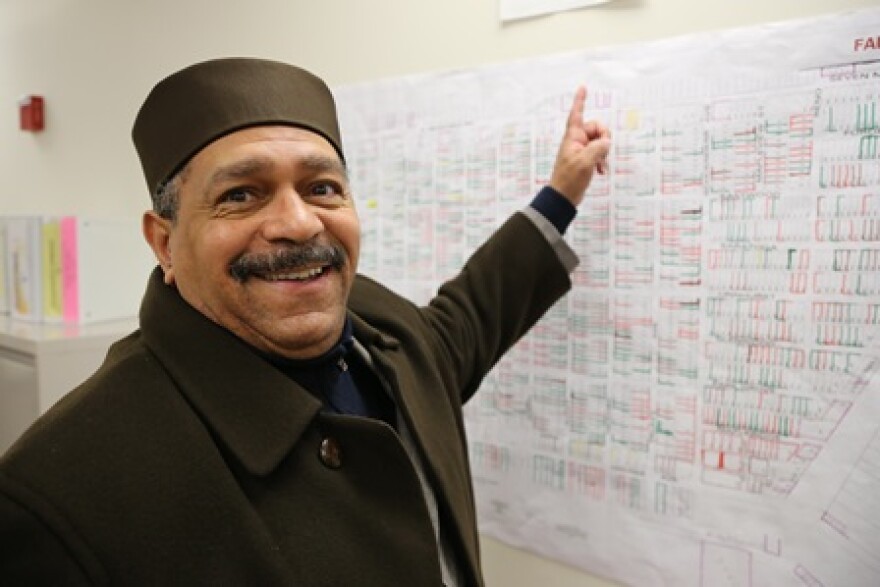It’s time to have The Talk.
I know, it’s not going to be easy. Might get a little uncomfortable, maybe make you squirm a little.
But it’s time; it's time to have a frank conversation about race. Now I know some of you listening right now are thinking "Race? Really? It’s 2013. Aren’t we past this by now?"
Good. I was hoping you’d ask that.
I'd like you to meet two young girls, both freshmen at a high school in Grand Haven, MI. Their names are Katie Bridgeforth, age 15, and Dystany Dunn, 14. Both girls are mixed, half white and half black, and they describe their skin as caramel colored.
The two girls ride the bus together to school every day, and that’s where the trouble started:
This wasn’t some isolated incident. The girls tell me about the boy who wore a KKK mask in the cafeteria, another one who wore it during homecoming weekend. Then there was the time a boy came up to Katie when she was taking a test, and he made a joke about slavery and ‘has she picked any cotton lately?’

And then, there was another school bus incident. In the audio below, the girls share how they don't walk around school by themselves anymore; they have friends walk with them to and from class.
I want to warn you that what Destiny and Katie are about to say uses a racial term listeners may find offensive:
I’m going to go out on a limb and say that Katie and Destiny in Grand Haven aren’t the only two in America being harassed because of their skin color.
Doesn’t sound quite like the post-racial society a lot of folks claim we live in today. And it’s not just overt racism that we’re talking about.
Steven Raphael is a public policy professor at the University of California, Berkeley. He says his definition of being "in a post-racial society would be one where race is not predictive of anything, and that’s certainly not the case." Raphael says today, just knowing a child or adult's race "will on average predict a number of outcomes, and it almost uniformly tends to be the case that African Americans fare worse on average on most outcomes."
David Harris is a provost at Tufts University and co-editor of a book called Colors of Poverty. He says, and there are mountains of evidence to back this up, that if you’re born Black in the U.S., you are less likely than a white person to make it to your first birthday. You’re less likely to have a college degree, more likely to have a parent in jail, live in a bad neighborhood with underperforming schools and high crime, and you’re considerably more likely to wind up involved in the criminal justice system.
Knowing a child's race "will on average predict a number of outcomes, and it almost uniformly tends to be the case that African Americans fare worse on average on most outcomes." - Steven Raphael, professor at UC Berkeley
Substitute Latino or Native American in place of Black and the outcomes are pretty similar.
And when you think about how our population is growing into a majority minority…those statistics start to take on new weight.
Take all those outcomes and combine them with historical discrimination like redlining and studies like the one that shows employers are more likely to hire an individual with a white sounding name than a black sounding one…and you’ve got what Harris calls “cumulative disadvantage.”
"It’s that old idea in part from the 1960s," says Harris, "that you can’t have individuals run a race, one of whom has a weighted vest and one of whom doesn’t, take the weight off and say everything’s equal move on. You have a different starting condition because of the history. So race matters in direct and indirect ways."
Let’s stay with the analogy for a minute…what if there was a program that said ‘look, we can’t remove the vest entirely, but what if we could lighten up considerably?
That's where the folks with Black Family Development hope to come in.
Black Family Development is working to transform two struggling neighborhoods in Detroit. They're basing their strategy in large part on the Harlem Children's Zone in New York City. A charismatic guy named Geoffrey Canada started the program more than a decade ago and used a "whatever it takes" approach to help kids in Harlem beat the odds. Today, the grand experiment known as the Harlem Children’s Zone is by all measures a success. It’s now a 100-block zone in the heart of Harlem with a safety net that starts at birth and goes through college.
Black Family Development wants to do the same thing for kids here in Detroit. And they’re calling it Promise Neighborhood.

Derek Blackmon, a community liaison for BFD, takes me on a tour of Osborn, one of the Promise Neighborhoods. It’s a mostly black neighborhood with one of the highest crime rates in Detroit. It also has a high vacancy rate, which is obvious as he drives me around, block to block.
Unemployment is high, poverty is high. The average household income in Osborn is around $12,000 a year.
We pass by drug houses; a gas station where Blackmon says lots of shootings take place; an abandoned house on a corner where a man attempted to rape a young girl.
More than a third of the people living in Osborn are children under the age of 18, and this is what they’re confronted with every day they step outside their front door.
Now, let's be clear here: there is no real Promise Neighborhood in Detroit…yet. The Obama administration came up with the Promise Neighborhood competition several years ago. Cities with the best plan to lift up a struggling community win the big bucks.
Black Family Development won a $500,000 planning grant a couple years ago, but when they went to apply for the full $6 million to implement the plan, they got shut out. So BFD is rolling out a pilot program, where they'll enroll 140 kids and track them on everything from attendance to tutoring to after school programs. The goal is to include the new data when they go to apply again this summer to try to win money to bring Promise Neighborhoods to Detroit.
The 140 kids will come from five schools in two neighborhoods in Detroit – Osborn, an overwhelmingly black neighborhood, and Clark Park, a mostly Latino neighborhood in SW Detroit.
Here's how the two Detroit neighborhoods compare:

I caught up with one mother who is enrolling all three of her kids into the Promise Neighborhood pilot. Her name is Phyllis Dotson, and like a majority of residents in Osborn, Dotson relies on food stamps and cash assistance to get by. Up until late last year, she and her kids were homeless and living out of the family van.
Dotson tells me she’s got some medical problems and can’t work, so she spends her days volunteering.
I asked her why she wants to enroll Jaleesa and her two siblings, Adam and Nikia in the Promise Neighborhood pilot:

The neighborhood Dotson and her children live in one the Kirwan Institute at Ohio State University would call "low-opportunity." A study shows that fully 90 percent of African American children in Michigan live in "low opportunity" neighborhoods, like Osborn.
More than half of Latino children in Michigan and 43 percent of Native American children live in low opportunity neighborhoods.
When it comes to white children, the percentage is significantly lower: just under 20 percent.
That means the vast majority of white children live in neighborhoods where the streetlights work and the cops come when you call; where there are good schools, and a viable job market.
The same can’t be said for the vast majority of children of color.
Shaquria Harris-Bey, Navia Daniel, and Tanesha George live on the west side of Detroit in a neighborhood called Brightmoor. They share what it's like to grow up in their neighborhood, an area where drugs and gangs are rampant and opportunities are hard to come by.
For further reading, viewing, and listening on race, check out this guide from State of Opportunity.



